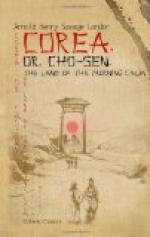A ceremony is to be found in the Land of the Morning Calm which corresponds pretty closely to “Tutti i morti” of Italy; I mean, the merry picnicking of distressed parents and relatives when they go and pray on the tombs of their dead. In Corea the occasion is usually celebrated on the first day of the first moon, or, in other words, on New Year’s Day. The family goes soon after sunrise, en masse, to the burial-place, where prayers are offered, and long sticks of incense burnt filling the air with the perfume so familiar to all who know the East. Food and drink are also generally brought and consumed by the mourners on such expeditions, with the result that the day which begins with praying generally ends with playing. Similar rejoicings are again indulged in during the third moon, when the tombs are usually cleaned and repaired, and the stone figures and horses washed and scrubbed, amidst the hilarious screams of the children and the less active picnickers.
The tombs of the kings do not differ very much from those of the richest noblemen, except that they have a kind of temple near them. At one time it was believed that the coffins in which the royal bodies were buried, consisted of solid gold. People who are well informed, however, maintain that there is no foundation for this statement about the royal graves, and that, on the contrary, they are almost as simple as those of the richer noblemen.
A strange tale was told me, which I shall repeat, as I know it to be true. It is to this effect: A few months previous to my visit to Seoul, a foreigner had visited the king soliciting orders for installations of telephones. The king, being much astounded, and pleased at the wonderful invention, immediately, at great expense, set about connecting by telephone the tomb of the queen dowager with the royal palace—a distance of several miles! Needless to say, though many hours a day were spent by His Majesty and his suite in listening at their end of the telephone, and a watchman kept all night in case the queen dowager should wake up from her eternal sleep, not a message, or a sound, or murmur even, was heard, which result caused the telephone to be condemned as a fraud by His Majesty the King of Cho-sen.
I should mention that a very good specimen of a Corean tomb is to be seen a few lis outside the East Gate, on the hillside, and that another, somewhat smaller, exists a short distance beyond the Pekin Pass outside the West Gate. It may also be noted that trees are frequently planted, and tablets erected, in proximity to Corean graves.
FOOTNOTES:
[3] Word used in the East
for a conglomeration of houses
enclosed
by a wall.
CHAPTER VIII
Seoul—The City Wall—A large image—Mount Nanzam—The fire-signals—women’s joss-house—Foreign buildings—Japanese settlement—An anecdote—Clean or not clean?—The Pekin Pass—The water-carrier—The man of the Gates.




